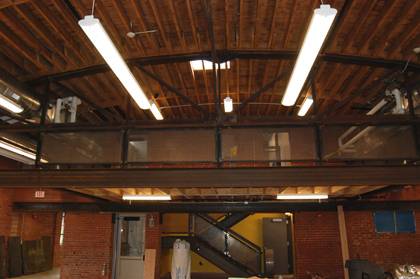Renovations Transform Historic Building
Old carpentry shop to serve as home for Master of Fine Arts in Experimental and Documentary Arts

Duke's old carpentry shop is getting new life this summer.
Read MoreIn a place where Duke staff built and repaired cabinets, flooring and furniture, Duke students and faculty will soon build their own musical creations, videos and more. This month, Facilities Management will complete a roughly $1.4 million renovation to the 7,140-square feet space for use as the home to Duke's new Master of Fine Arts in Experimental and Documentary Arts.
Work began in June to transform.the building into a workshop/learning space by Aug. 29, when classes begin.
A key to the renovation was maintaining the look and feel of the old carpentry shop, which moved from the corner of Campus Drive and Maxwell Avenue to a Facilities building about one-tenth of a mile away at the intersection of West Pettigrew and Sumter streets. The renovation left original brick walls untouched and kept yellow safety markers on flooring that were previously used to mark workspaces in the carpentry shop.
"It was very important for us to recognize the historical presence of a place where Duke people would make wonderful things," said Tom Rankin, director of the Center for Documentary Studies. "We saw this renovation process as a chance to embrace the idea that whatever happens in the future is very much related to Duke's past."
Floyd Williams, project manager with Facilities Management, said Duke doesn't have records on file to know how old the building is, but photos from the early 20th century suggest the carpentry shop was constructed during the 1930s. Historical aspects of the renovation include using old metal flooring as splash guards for a community sink, leaving steel trusses attached to the original ceiling and preserving steel-frame windows.
"With a lot of projects like this, you would just tear down the old windows and replace them with more energy-efficient ones," Williams said. "We were able to save the old panes and replace them with double-pane glass that will still be effective in maintaining indoor temperatures."
Work on the new art space also features several modern upgrades. Facilities installed an accessible wheelchair lift for the two-story building as well as new bathrooms, water fountains and yellow-painted accent walls throughout the shop. Carpeting has also been installed on the building's second floor, where there will be a computer lab as well as a work area that doubles for film screenings.
Rankin said his favorite aspect is a new mezzanine level that will act as a lounge area built especially for the Experimental and Documentary Arts program.
"We envision it as a hang-out space for faculty and students," he said. "It's a great touch to a lot of renovations that intersect the past, present and future of Duke."